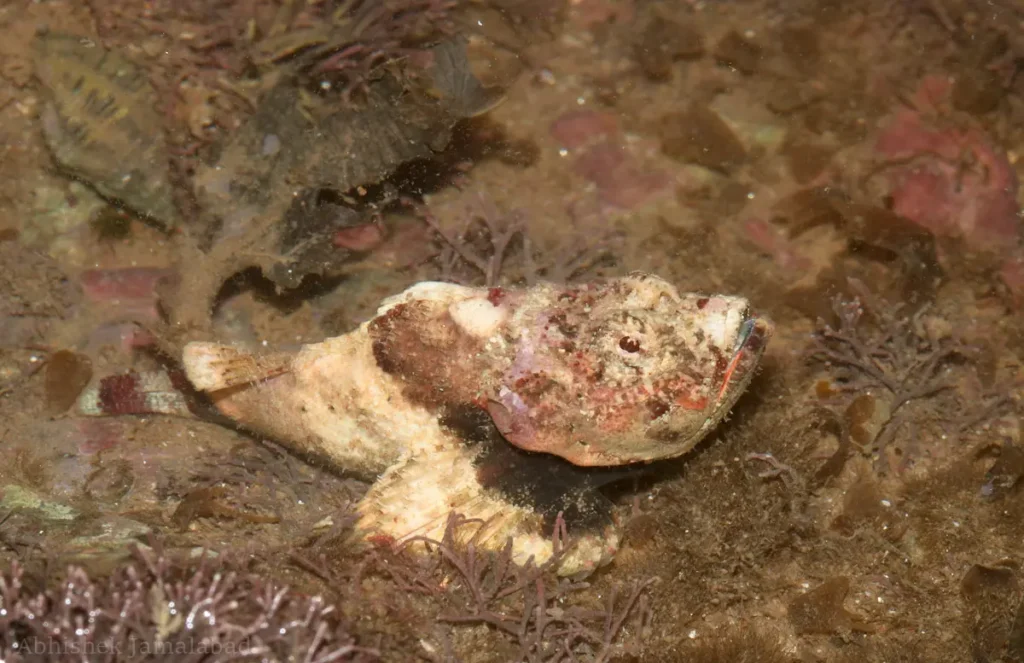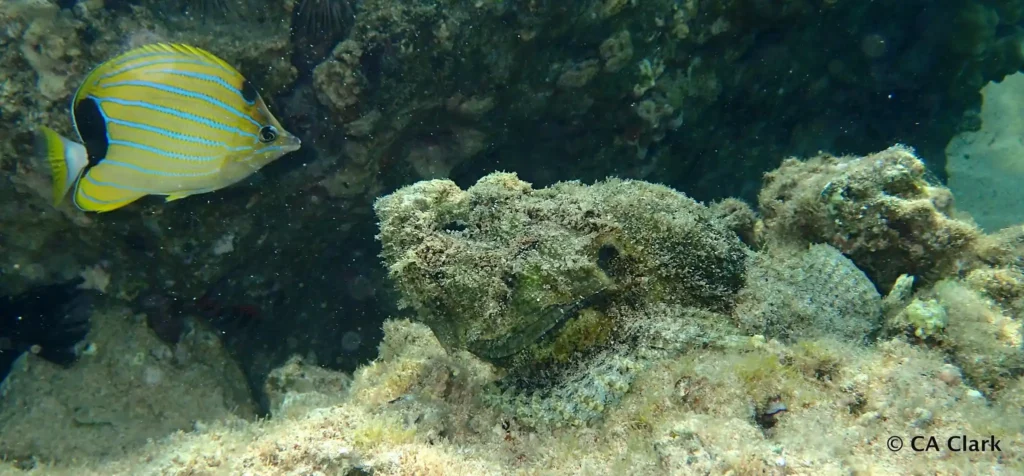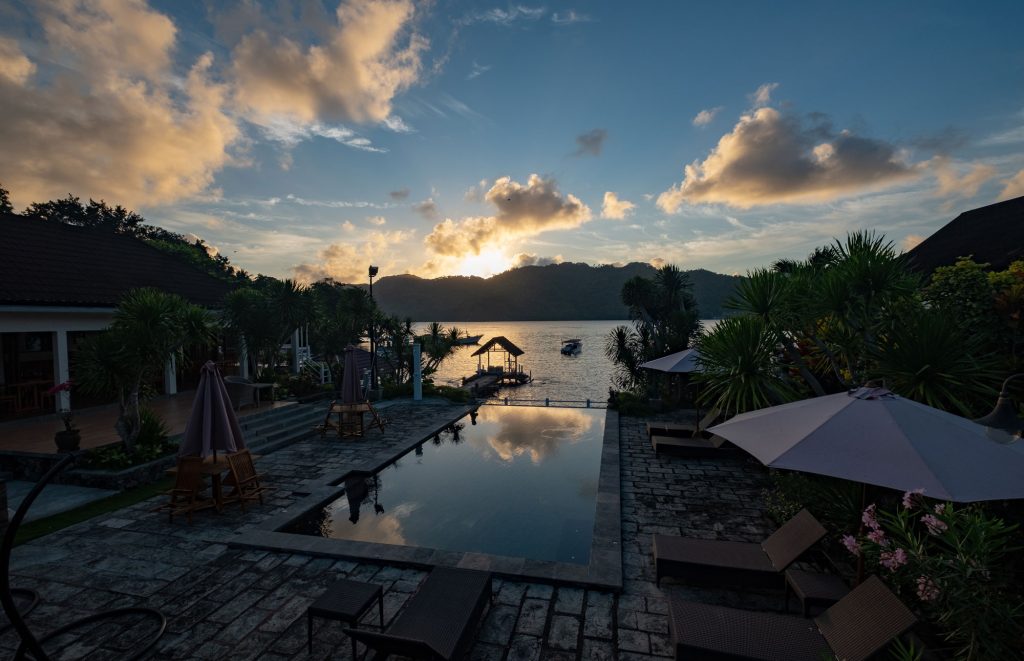Have you ever looked down while diving and thought you were staring at a rock, only to realize the “rock” was staring back?
That’s the trick devil scorpionfish use to hunt. It blends into the seabed so perfectly that most people swim right past it without knowing. With its rough edges, eerie look, and clever hunting style, this fish is the living proof that the ocean is full of surprises.
Curious how it pulls off the disguise and why divers love spotting it? Keep reading, because this little trickster has more surprises than you think!
What Is the Devil Scorpionfish, and Why the Name?

The devil scorpionfish (Scorpaenopsis diabolus) is one of the ocean’s best masters of disguise. To most eyes, it looks like a lump of coral or a rough patch of rock resting quietly on the seabed. In reality, it’s an ambush predator armed with venomous spines, lying in wait for anything unlucky enough to swim close.
Its spooky nickname comes from a mix of looks and defense. With a permanent grimace, a pronounced hump on its back, and eerie skin flaps over its pupils, it has a devilish expression that suits its name. The word diabolus itself is Latin for “diabolic,” which nods to both its sinister appearance and painful sting.
Some divers also call it the “false stonefish,” since it closely resembles the highly venomous stonefish. Don’t be fooled by the “false” part, though. While not as deadly as its cousin, the devil scorpionfish still packs venom strong enough to make any careless encounter a painful memory.
Where Can You Encounter the Devil Scorpionfish?
Devil scorpionfish (Scorpaenopsis diabolus) are most often found on coral reefs, rocky patches, and sandy bottoms with scattered rubble. They live at depths of about 1 to 70 meters, perfectly blending in with algae, corals, or even broken shells. For divers, that makes spotting one feel like uncovering a secret hidden in plain sight.
Here are five of the best places to encounter them:
- Lembeh Strait, Indonesia: A world-class muck diving destination where black volcanic sand and coral rubble provide the perfect hiding spots for devil scorpionfish.
- Anilao, Philippines: Famous for its rich macro life, with sandy slopes and coral rubble where these camouflaged hunters love to settle.
- Palau, Micronesia: Known for pristine reefs and diverse marine life, Palau offers divers a solid chance of finding devil scorpionfish among the coral patches.
- Great Barrier Reef, Australia: The vast reef system holds many scorpionfish species, including the devil scorpionfish, often seen resting on coral gardens.
- Red Sea, Egypt: With its mix of reefs and sandy stretches, the Red Sea is another spot where this species lurks quietly, waiting for prey to pass by.
How Does It Hunt?

The devil scorpionfish (Scorpaenopsis diabolus) is the definition of patience in the ocean. It spends hours sitting perfectly still, blending so completely with corals, algae, and rubble that most divers swim right past without ever noticing.
But when a small fish or crab makes the mistake of wandering too close, the scorpionfish strikes in an instant. Its huge mouth snaps open, creating a sudden suction that pulls the prey straight in. Like other scorpionfish, it can handle surprisingly large meals for its size, swallowing them whole with ease.
And if anything dares to bother it, the devil scorpionfish has one more trick up its sleeve. It spreads its fins wide to reveal bright inner colors, flashing a warning display that says loud and clear: stay back.
You might also like: Weedy Scorpionfish: Behavior, Habitat & Photo Tips
How to Dive Safely Around the Devil Scorpionfish
Despite its intimidating name and venomous spines, the devil scorpionfish is not aggressive. It relies on camouflage as its main line of defense and usually raises its spines only if it feels truly threatened. More often than not, it will shuffle away on its pectoral fins rather than pick a fight.
To enjoy a safe and memorable encounter, keep these tips in mind:
- Maintain excellent buoyancy: Staying in control helps you glide smoothly above the seabed and avoid disturbing the sand or bumping into hidden marine life. In places like Lembeh, the fine volcanic sand can be stirred up easily, so steady movement makes the dive more enjoyable.
- Look, but don’t touch: Always pause before resting your hands on rocks, corals, or sandy areas. Using a dive light helps reveal well-camouflaged creatures and adds to the fun of spotting them.
- Keep your distance: When you find one, take your time to watch it from a comfortable space. Slow movements and a respectful distance let the fish remain relaxed while you enjoy the view.
What Should You Do if You Get Stung?
A sting from a devil scorpionfish can be painful, but it is rarely life-threatening (source, source2). The most important thing is to stay calm and focus on the right steps. Its venom is sensitive to heat, which means with proper first aid, the pain can often be managed quickly and effectively.
Here’s what to do if you or your buddy gets stung:
- Exit the water safely: Get to shore or the dive boat without rushing. Staying calm helps prevent further injury.
- Keep the area still: Rest the affected limb and make yourself comfortable in a half-sitting position.
- Clean the wound: Rinse gently with clean water and remove any obvious spine fragments if they are easy to reach.
- Apply hot water immersion: Place the affected area in water that feels hot but not scalding (around 42-46 °C). Keep it immersed for 30 to 90 minutes, or as long as it brings relief. The heat helps reduce pain and neutralize the venom.
- Seek medical attention: Even if the pain lessens, a doctor should check the wound to ensure proper care and prevent complications.
Most divers recover fully after following these steps, especially when medical care is sought promptly. Staying calm and acting quickly is the best way to manage this situation.
Experience the Thrill of Diving with Devil Scorpionfish with Solitude

The devil scorpionfish is one of the most fascinating creatures you can encounter underwater. Its camouflage, hunting tricks, and unique features make every sighting feel like uncovering a hidden treasure. Understanding how it lives and where to find it adds even more depth to the experience, turning a simple encounter into a lasting memory.
At Solitude Lembeh Resort, our PADI-certified dive guides use their unmatched local knowledge to spot these masters of disguise and countless other rare critters. They handle the search so you can focus fully on the thrill of the dive and the joy of capturing the perfect photograph. When the adventure ends, you return to the comfort of your private villa, where a warm, home-cooked meal awaits you.
Book your next dive adventure with Solitude and meet these devil scorpionfish yourself!